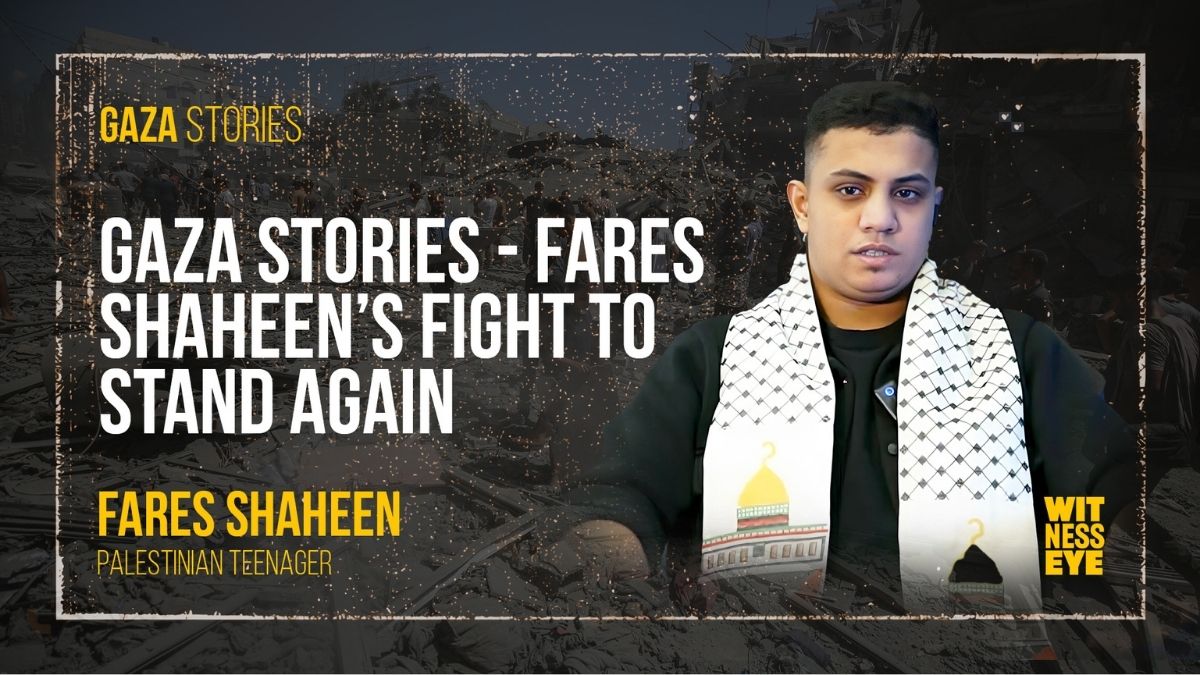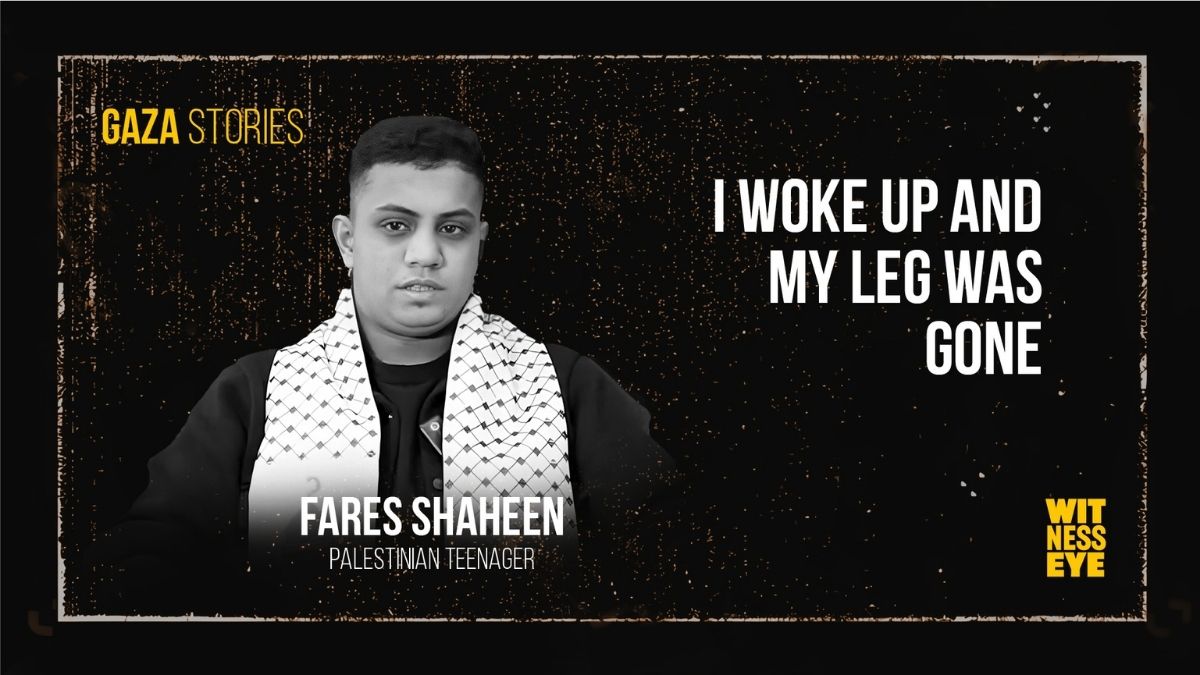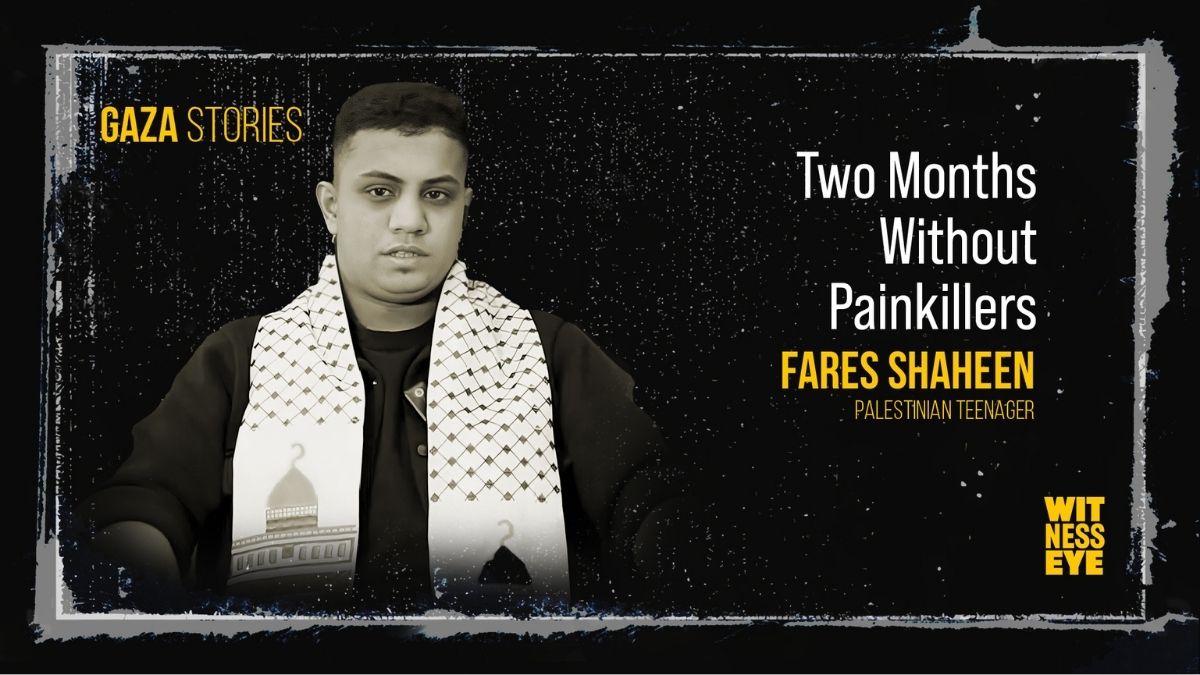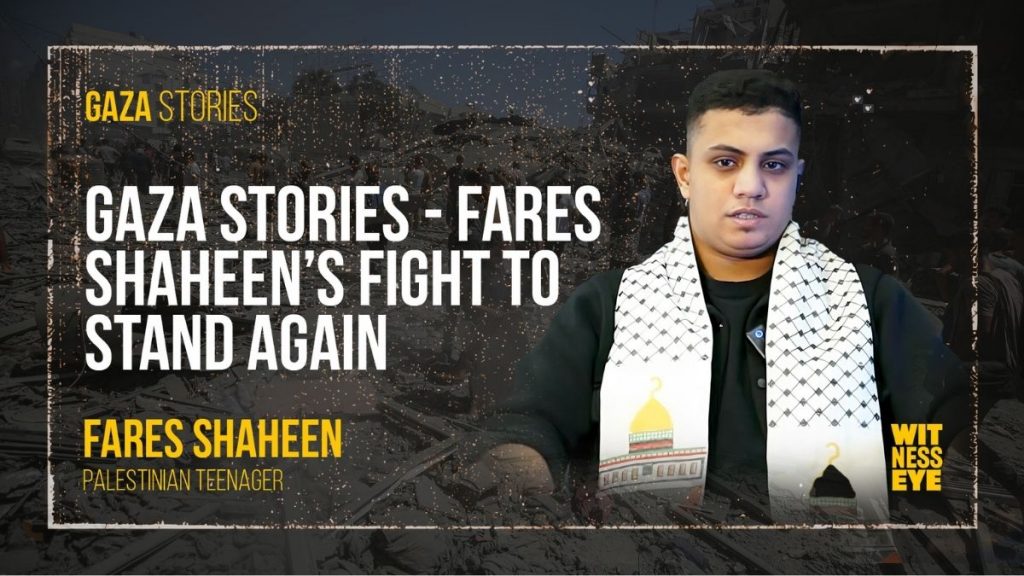
Gaza Stories begin in ordinary places—a school desk, a kitchen table, a quick run to the corner store. For 17-year-old Fares Omar Shaheen, it began at the meat counter of a mall in Nuseirat. He had come to buy groceries for his family; he left without a leg, scorched by fire and pulled to safety on a donkey cart. “People were shopping normally, and we were bombed,” he tells me. “Hardly anyone survived. They started collecting people in the mall carts—body parts in carts.”
This is one of the Gaza Stories we are bound to document—because these are not numbers, they are names, faces, futures interrupted. It belongs alongside the archive of Eyewitness Testimonies and Civilian Impact Reports we keep so the world can no longer say it didn’t know.
Read more in the Gaza Stories category.

“I Woke Up and My Leg Was Gone”
Before the war, Fares was a high-schooler—“grade 11–10,” he says with a shy shrug—who wanted what most teenagers want: to finish school, maybe study something practical, help his family. On October 18, he stepped into the mall at Nuseirat, “talking with the man” behind the counter, when the building shook.
“I passed out immediately,” Fares says. “My leg was amputated… I had burns on my back and fingers. The other leg was injured, too.” There were no ambulances at first; he was loaded onto a donkey cart, then transferred half-way to an ambulance. By the time he reached the hospital, the emergency ward was overflowing. “There were no painkillers… no food. Nothing for one to heal,” he says. “I woke up in intensive care. I looked and my leg was gone.”
In the language of International Humanitarian Law, markets and medical facilities are protected places. In the language of Gaza Stories, they are simply where life happens—until it doesn’t.
Gaza Stories – A Child of Wars Says This One Is Different
Gaza’s teenagers have grown up counting conflicts the way others count school years. Fares remembers earlier escalations. “But in this war, they didn’t spare schools or hospitals,” he says. His uncle and cousins were killed while sleeping in a school in Nuseirat—a place they were told would be safe. He repeats the refrain Gazans have learned by heart: there was no safe place.
What he describes maps onto recurring patterns our newsroom has catalogued under Crimes Against Humanity, Gaza war crimes, and the Destruction of Civilian Infrastructure. It echoes testimony we’ve gathered across the Strip in Stories of Survival and in our Digital Evidence Archive.
We have heard this structure before: an instruction to move, a strike on the very place of refuge, and then the impossibility of evacuation for the wounded. It’s why parallel efforts like Civilian Casualty Mapping and War Crimes Documentation matter—so patterns survive the spin cycle.

“Two Months Without Painkillers”
Fares remained in Gaza for two months after the blast. “Two months without anything—no painkillers,” he says. At last, in December, he was evacuated to Turkey with his father as companion—“God made it easier for us.” Surgeons operated. He is grateful—“First God, then them”—but the realities of recovery are plain. “I have a prosthetic limb that isn’t good at all… it’s not useful. We want good prosthetics,” he says. Phantom pain and swelling keep him in a haze of pills: “If I want to sleep, I need a painkiller. My life isn’t normal anymore.” Fares wanted to return to class, to finish his last year and apply to university. “With the pain and suffering, there’s nothing one can do… you need a quiet place to sit,” he says.
We have published pieces that rhyme with his: Gaza Stories — Hossam’s Fight to Witness, Gaza Stories — Final Words: Between Grief and Duty, and Gaza Stories — A Mother’s Last Words, A Family’s Goodbye. Each story is a room in the same house: loss, shock, stubborn human will.
A Family Scattered, Then Counting the Missing
“My family is 12 people… 12 were martyred,” Fares says flatly. His mother and siblings became serially displaced—Rafah tents, school floors, short returns to Nuseirat, then flight again. With his father in Ankara, his mother “took on the role of both mother and father,” hunting for flour and water through the famine months, often without connectivity to call for help.
Their ordeal belongs with our ongoing coverage of Gaza’s Missing and Gaza justice; it resonates with earlier reporting such as Gaza’s Missing: Thousands Lost in the Shadow of War and Gaza Justice: Voices of Justice and Grief from Gaza. The Gaza Stories we gather layer personal testimony onto a broader record—the spreadsheet of the unreturned, the names etched in phone notes, the graves hastily dug in courtyards when cemeteries were unreachable.

Gaza Stories – The Long After of an Instant
In Ankara, Fares sees other young amputees in waiting rooms and corridors. “We see each other… people are for each other,” he says, but little formal psychological support has reached him. He is 17 and he speaks like someone decades older: “My mental state is tired. It’s not normal.” He wants to stand—not metaphorically, but simply to move without pain. “We need good prosthetic limbs… We’re not comfortable or stable with the ones we have,” he says.
These needs are concrete, verifiable, and urgent. They belong on any Accountability Watchlist, and they belong within Legal Accountability Cases that consider sustained harm: not only the moment of the blast, but the month after, and the year after—the missing meds, the denied evacuations, the engineered shortages of supplies. The arc from strike to scar is the space where Forensic Investigations and Military Conduct Analysis must work in tandem with care providers and mobility experts.
Killing Civilians
If asked to testify, Fares says he would start with the obvious. “We are young children. How can someone 15 or 16 lose their leg in a mall?” He rejects the idea that this was self-defense: “You’re killing civilians in tents, burning them… small children playing in the street—are they holding weapons?”
His question is not new; it sits beside the stacks in our Gaza Tribunal Reports and the dossiers in Genocide Evidence Files and Gaza Tribunal evidence. It echoes in the record of public hearings, including the Bosnia public session of the Gaza Tribunal, where expert witness Gaza testimony is being assembled for international justice and Gaza legal review.
“The world should have stopped the war long ago,” Fares says. “Don’t make us numbers. Tell our story to the world.”
Tents, Truces, and the Myth of Safety
Fares’s account includes tactics that appear repeatedly in our source material and our Gaza Stories archive: decoy calls about aid, sudden drone strikes at doors, attacks at hospital gates, and a logic of siege that weaponizes bread and signal bars. “They burned people in the middle of the tents,” he says of Rafah. “At Al-Aqsa Hospital they bombed people in tents at the door. A hospital should be somewhat safe.”
This is why we piece together Social Media Evidence with field reporting; why we publish Civilian Impact Reports that show what happened, where, and to whom; and why we cross-reference every testimony we can with photos, videos, coordinates, and the medical timeline. The work is slow, imperfect, and necessary.
For deeper background on how civilian experiences are being recorded beyond the nightly news cycle, see our Gaza Tribunal’s first public session in Bosnia and our reporting from the Gaza Tribunal channel.
More from the Gaza Tribunal category.
Latest case updates in News.

What the Future Owes Fares
The future owes Fares time—to heal, to re-learn balance, to try out prosthetics until one fits, to sit in a classroom without flinching at a slammed door. It owes him a name in a registry that is not only of the wounded but of those who must be fit for life again: a living roll call we continue to build in Gaza’s Missing and survivor lists. It owes his mother and siblings security without quotation marks.
But above all, the future owes him an answer. If Gaza Stories mean anything, they are our insistence that a child who went to buy meat for dinner should not become a case study. They are our refusal to accept that a shopping cart is an ad-hoc morgue. They are our witness, archived and indexed so the world cannot conveniently forget.
“We wish for peace,” Fares says at the end. “God willing, Palestine will be liberated. Don’t forget us.”
He asked for better prosthetics and for someone—anyone—to help steady his steps. We can at least make sure his words don’t fall.
Related Gaza Stories
This piece joins our growing library of Gaza Stories, which also informs the ongoing War Crimes Documentationeffort and Gaza Tribunal Reports.
Editor’s note on sourcing
This article draws exclusively on Fares Shaheen’s recorded testimony and our internal documentation channels, including Witness Eye tag repositories and related case files such as Digital Evidence Archive. For more survivor narratives, see the Gaza Stories tag page.
Now, hear the testimony of Farees in his own words—survivor and witness—carrying Gaza’s grief, memory, and unyielding call for justice into the record of history.
Published By Besa Witness Eye
Stay Connected with Witness Eye
Follow us on our official channels:
